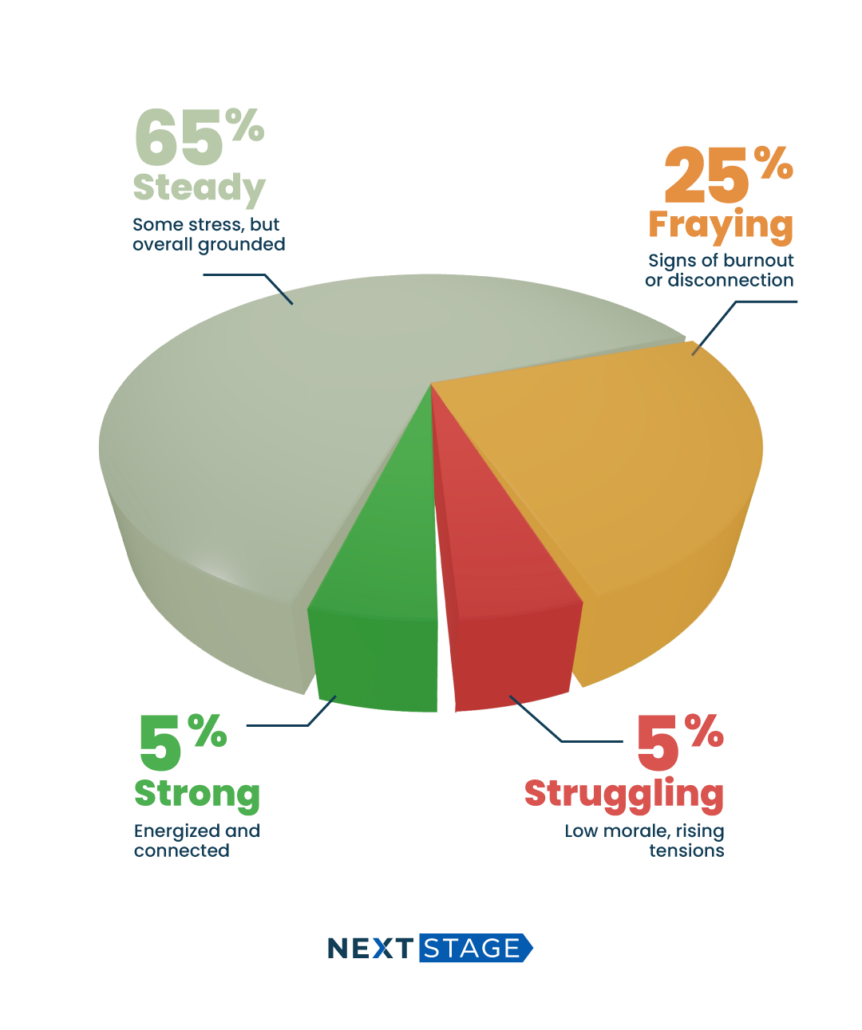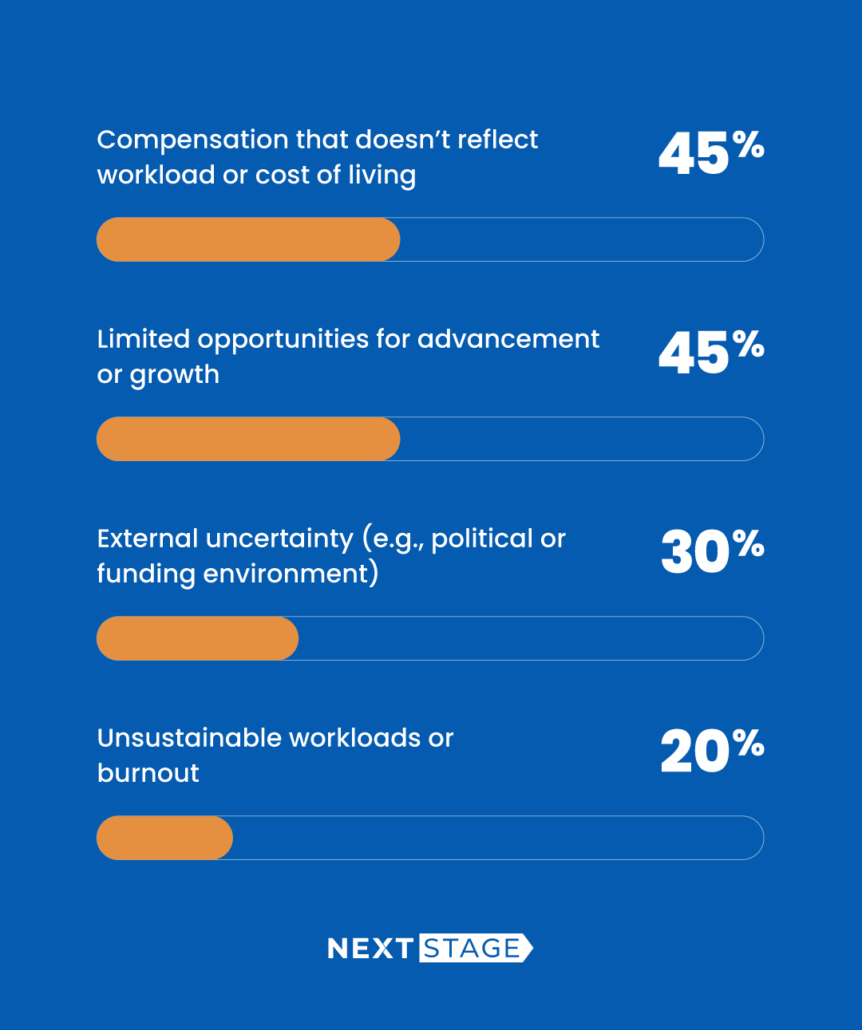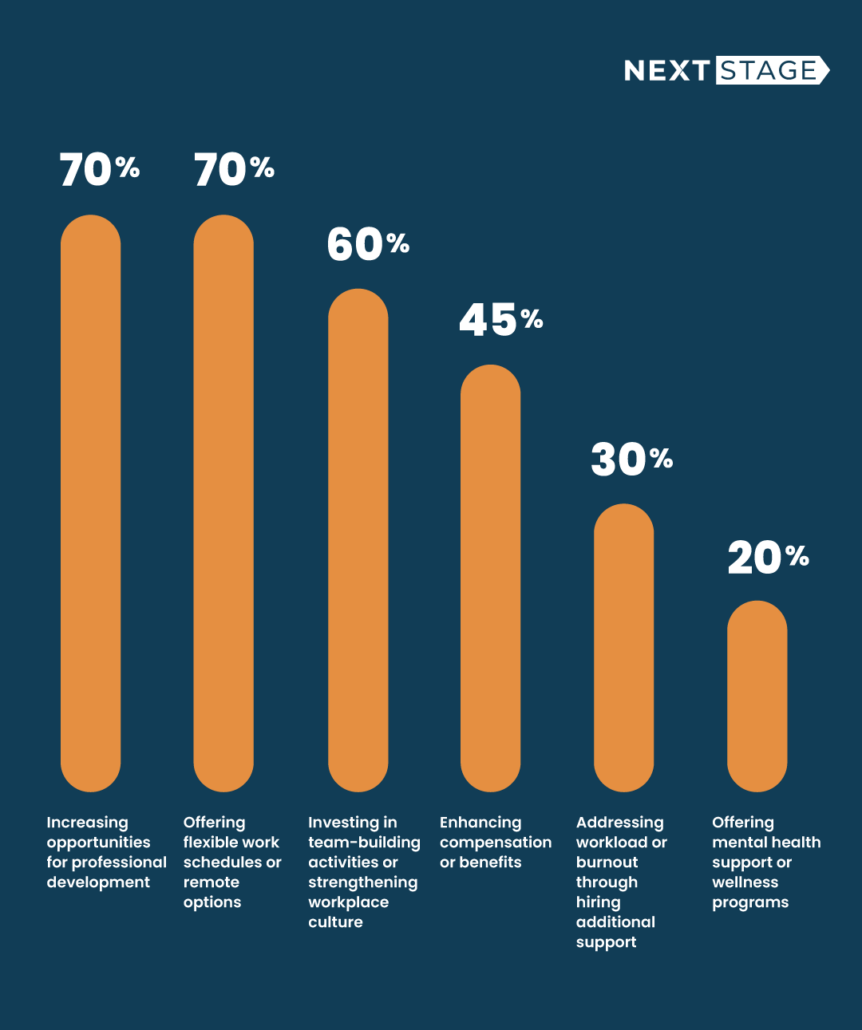At a moment when social good work feels more critical than ever, many leaders are wrestling with an increasingly urgent question: How do we keep our teams motivated, supported, and committed in the face of rising pressure and uncertainty?
Workplace culture isn’t just a “nice-to-have” for nonprofits — it’s mission-critical in a sector where burnout is common, resources are stretched thin, and the emotional weight of the work runs high. When the day-to-day feels overwhelming, it’s the strength of your culture — trust, communication, belonging — that determines whether your team can weather the storm.
That’s why we launched a survey to understand the current temperature on team morale, staff retention pressures, and what’s working to keep people engaged. Whether you’re trying to stabilize a struggling team or future-proof your staff strategy, this data can help guide your next steps.
Here’s what we heard from leaders in our network — and what it means for the months ahead.
 Who Participated? A Snapshot of Our Respondents
Who Participated? A Snapshot of Our Respondents
We gathered insights from 20 participants, each bringing valuable perspectives shaped by their leadership roles and organizational contexts. The respondents primarily represented nonprofit organizations, with a strong presence of executive leaders committed to advancing mission-driven work across North Carolina communities.
Sector Representation
- 95% of respondents came from nonprofit organizations working across a wide set of impact areas, including health, human services, education, arts and culture, and more.
- One respondent represented the for-profit sector, working in direct service delivery with a social impact orientation.
Role Representation
- 75% held executive leadership positions, including CEOs, executive directors, and vice presidents, reflecting a strong voice from decision-makers within their organizations.
- 15% worked in operations and administration, with a small number representing roles in communications, fundraising, and frontline program delivery.
Geographic Representation
- The survey data highlights a strong cluster of nonprofit leadership in Mecklenburg County and surrounding areas, offering a snapshot of organizational activity and influence within the region.
- Other geographies represented include: Huntersville, Mint Hill, Greensboro, and Winston-Salem.
 Most Teams Are Steady — But Some Challenges Are Emerging
Most Teams Are Steady — But Some Challenges Are Emerging
When we asked how teams are really doing, most respondents (65%) said morale is steady — there’s stress, but teams are hanging in there. Still, nearly one-third reported signs of burnout or disconnection, and one described morale as outright struggling.
How respondents described morale:

This paints a picture of resilience, tempered by real concern about sustainability. As one leader put it, “We’re staying focused on the people we serve.”
 What’s Putting the Most Pressure on Staff Retention?
What’s Putting the Most Pressure on Staff Retention?
The most common factors weighing on retention aren’t new, but they are increasingly interconnected:

These responses show that retention challenges aren’t about any one issue — they’re the result of multiple forces converging. Many respondents named several factors at once, reflecting just how deeply personal and organizational stressors overlap.
One leader also pointed to the influence of “personal lives” on staff stability, highlighting how external pressures, like caregiving responsibilities, housing insecurity, or mental health, can directly impact workplace engagement.
 How Are Organizations Responding?
How Are Organizations Responding?
Leaders shared a wide range of actions planned to retain their employees this year:

Professional development and flexibility are leading the charge.
- The most common responses were increasing opportunities for professional development and offering flexible work schedules or remote options — each cited by 70% of respondents. These options reflect a growing understanding that career growth and flexibility are central to staff satisfaction and long-term commitment.
Culture-building remains key.
- 60% of respondents are investing in team-building activities or strengthening workplace culture, signaling that nonprofit leaders are prioritizing community, connection, and shared values as a path to retention.
Compensation matters, but it’s not everything.
- While 45% are enhancing compensation or benefits, it’s notable that nonfinancial strategies like flexibility and culture-building were mentioned more often — perhaps pointing to budget constraints or a broader redefinition of what makes a workplace supportive.
It’s clear that many nonprofit leaders are trying to be as responsive and adaptive as possible — but there’s also room to grow, especially in supporting staff well-being in more holistic ways.
 What’s Actually Working?
What’s Actually Working?
While these numbers help us understand trends across the sector, it’s the qualitative insights that bring the real story to life. We asked leaders what’s helping their teams stay engaged, and here’s what they said:
“Connection among team members.”
“Transparency and communication.”
“Time to gather and celebrate.”
“Focusing on the positive things we’re doing.”
“Giving team members a voice.”
“Our strong relationships with each other.”
Themes of belonging, communication, and meaningful connection stood out loud and clear. Leaders who create space for community — not just productivity — are seeing results:
“We’ve prioritized staying relationally strong so we can keep doing impactful work together.”
 Encouragement From One Leader to Another
Encouragement From One Leader to Another
We closed by asking an optional question: What advice or words of encouragement would you give to others leading teams right now?
40% of respondents chose to leave words of wisdom for others, demonstrating our sector’s willingness to step up and support one another. Here’s a snapshot of their insights:
“Help your team to recognize how their individual contributions every day drive the mission of the organization.”
“Listen to understand. Be a bridge for your team, not a wall.”
“Take care of yourself as a leader. You’re probably feeling increased pressure and anxiety. Know that no one knows what’s coming next or how things will shake out, so don’t hold yourself to the expectation that you have to know it all either.”
“Lead with empathy and clarity. People are carrying more than we often realize, so creating a space where your team feels seen, heard, and supported goes a long way. At the same time, don’t be afraid to cast a clear vision — people want to know where they’re going and why it matters. Stay consistent, stay human, and trust that even small moments of encouragement can have a big impact.”
These words reflect what we hear in our work every day: the nonprofit sector is full of people leading with heart, even when times are tough.
 So, What Comes Next?
So, What Comes Next?
Nonprofit work has always demanded passion and perseverance. In 2025, it also demands a renewed commitment to the people behind the mission. With burnout, budget pressures, and shifting expectations all in play, workplace culture is no longer a side conversation — it’s central to organizational sustainability.
If your organization is navigating these waters, know this: you’re not alone. And the more we learn from each other, the better we can support the people doing the work that matters most.
Whether your team is thriving, holding steady, or struggling, now’s the time to:
- Revisit your retention strategies
- Prioritize real conversations about morale
- Double down on transparency, flexibility, and team connection
Because when your people thrive, your mission does too.
![]() Stay tuned for the next survey in the series by subscribing to our monthly newsletter — and thank you for being part of this work.
Stay tuned for the next survey in the series by subscribing to our monthly newsletter — and thank you for being part of this work.
![]() Want help translating insight into strategy? Next Stage helps nonprofits and other social good organizations with organizational strengthening and team building. Let’s talk today.
Want help translating insight into strategy? Next Stage helps nonprofits and other social good organizations with organizational strengthening and team building. Let’s talk today.
